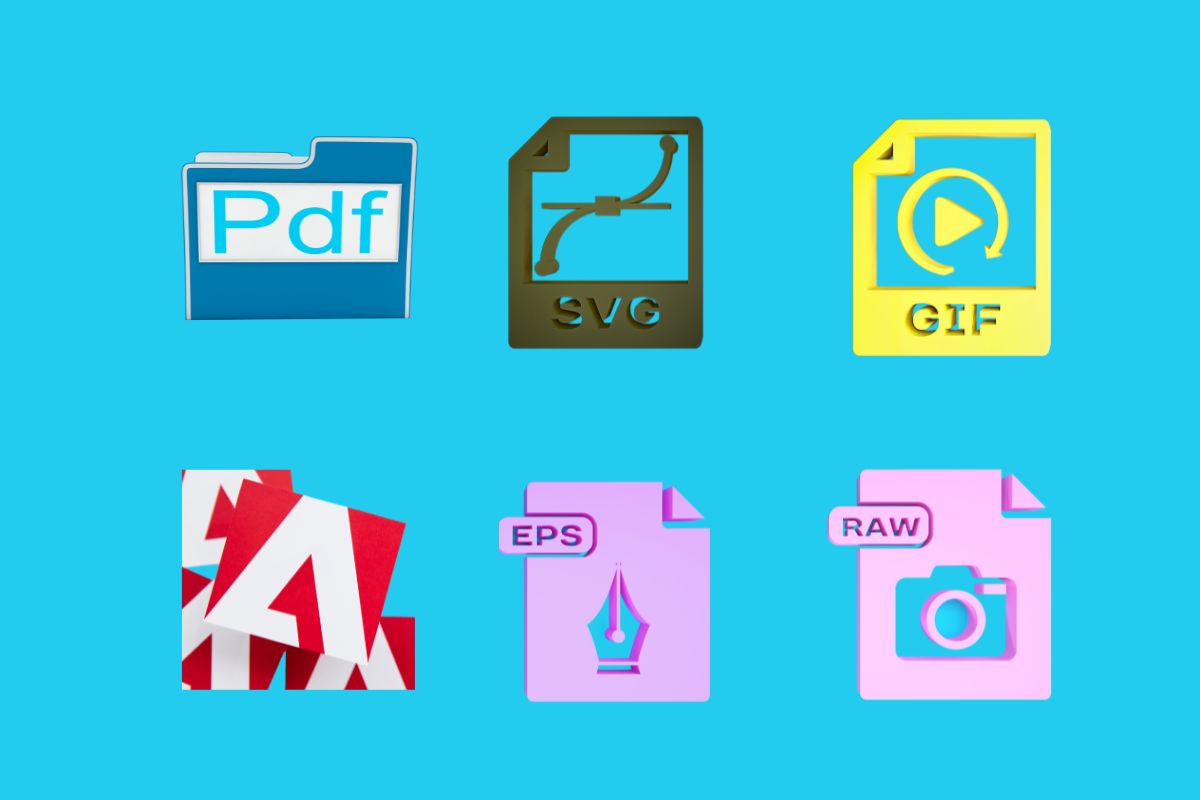A vector file is a type of digital graphic that uses mathematical formulas to represent images in computer graphics. Unlike raster graphics, such as JPEG or PNG files, which are composed of pixels, vector files are made up of paths defined by a start and end point along with other points, angles, and curves. These paths are used to outline shapes which can be filled with colors or patterns.
The scalable nature of vectors allows you to enlarge or reduce the size of your graphics without losing quality. This makes vector files ideal for logos, icons, typographic designs, and other graphics where you need them to remain sharp and clear at any size. Popular vector file formats include SVG, AI, and EPS, each with its specific use cases and compatibility with different software and devices.
Editing a vector file requires specialized software that can handle the paths and shapes defined by the vector format. Programs like Adobe Illustrator and Inkscape are designed to create and modify vector images, offering a range of tools for shaping and styling the vectors. The precision and flexibility of vector files make them a preferred choice for both print and web design, providing you with consistently crisp and clean visuals irrespective of how you choose to scale them.
Understanding Vector Files
In this section, you’ll learn precisely what vector files are, how they differ from raster files, and the common types of vector file formats you might encounter.
Definition and Characteristics
Vector graphics are based on mathematical formulas that define points, lines, curves, and shapes on a plane. This means when you scale a vector file, its quality remains unchanged because it recalculates the image using the formulas, not pixels. These files boast an infinite resolution, ensuring visuals stay sharp and clear at any size without becoming pixelated.
Vector vs. Raster Files
The fundamental difference between the two lies in image rendering. Raster files, also known as bitmap or raster graphics, consist of a grid of pixels that define their resolution. Unlike vector files, increasing the size of a raster file leads to loss of quality and pixelation. Raster images are favored for detailed photographs, while vectors are ideal for designs that require scalability and crisp outlines.
Common Vector File Formats
Vector graphics come in various file formats, each with a specific application and capability:
- Scalable Vector Graphics (.svg): a versatile, web-friendly format that renders vectors on the fly.
- Adobe Illustrator (.ai): widely used by professionals for intricate vector designs.
- Encapsulated PostScript (.eps): contains a mix of text and graphics for high-quality print products.
- Portable Document Format (.pdf): can contain both raster and vector graphics, typically used for documents.
These formats ensure that your designs maintain high quality and fidelity across different mediums and use cases.
The Role of Vector Files in Design

Vector files are integral to maintaining the clarity and scalability of your projects, from intricate logos to comprehensive branding materials.
Graphic Design and Branding
In graphic design, consistency is king. Your brand’s logo, a cornerstone of your identity, demands the use of vector files for its creation. When you’re working on branding materials, vector files ensure that your logo maintains its quality at any size, whether it’s on a business card or a billboard. Vector-based illustrations contribute to a cohesive look across your branding assets, be it digital graphics or print designs.
Print Media and Advertising
For print media, vectors are non-negotiable. The precision vectors offer is invaluable for crisp printing of your advertising materials. Whether you’re dealing with large-format printing like billboards or smaller items like business cards, vector files can be scaled up or down to any size without a loss of detail or clarity, ensuring that your advertising message is delivered as intended.
Digital Media Applications
When it comes to digital media, vectors are versatile and responsive. In a web browser or across the internet, vector designs and digital illustrations stay sharp on any screen resolution. This adaptability is crucial for digital advertising, where your designs must look just as polished on a smartphone as they do on a desktop, ensuring your message is effective regardless of how your audience accesses it.
Working with Vector Files

Vector files are essential for precision graphic editing since they store design aspects as mathematically defined entities. These entities like curves, lines, and colors can be manipulated at will without loss of quality.
Editing and Manipulation
When you edit vector files, you handle scalable elements such as paths, curves, and lines. A major benefit to this is that you can resize your vector image without any distortion. Programs like Adobe Illustrator and Inkscape offer a ‘Pen’ tool, which allows you to create complex shapes and lines through control points. It’s the precision of these tools that enables designers to manipulate intricate parts of a vector graphic, like altering colors and shapes with ease.
Conversion and Compatibility
Converting vector files to raster files (like PNG, JPG, or GIF) is a common task that necessitates understanding conversion processes to maintain visual integrity. Remember, converting to raster files (or bitmap images) should be done with consideration to the resolution; higher is often better for clarity. Conversely, converting bitmap images back to vector is complex and might require dedicated software or tools to trace the bitmap and recreate it as a vector. This process is crucial to preserve compatibility across different platforms and devices.
Software and Tools
A variety of software options are available for working with vector files. Adobe Illustrator is a standard in the industry, known for its extensive features catered to professional designers. CorelDRAW offers robust capabilities and is another favored choice among graphic professionals. For those looking for free software, Inkscape is a powerful open-source vector editor that is compatible with many vector formats. Your choice in software should align with your specific design needs and proficiency level.
Remember, the tools you choose greatly influence your design workflow, so select and master them to ensure your vector editing is efficient and effective.
Advantages of Vector Files
Vector files offer a range of benefits that make them a go-to choice for designers and professionals working with digital graphics.
- Scalability: When you’re working with vector files, you can scale your images up or down without losing resolution. This means your graphics remain sharp and crisp, even when you enlarge them, making vectors ideal for logos and other designs that need to be used across various media sizes.
- Flexibility and Editability: The elements within vector files are extremely flexible and editable. You have the ability to manipulate individual components without affecting the overall design, which gives you full creative control to adjust shapes, colors, and sizes as needed.
- Universal Compatibility: Being a universal format, vector files can be opened and edited with many types of software, ranging from professional graphic design programs to basic drawing tools. This compatibility ensures your work can be shared and edited across different platforms and applications.
- Efficient File Size: Despite their versatility, vector files are often more compact than raster images, particularly for designs with geometric shapes and few colors. This makes them easier to share and faster to load, especially important for web graphics.
- Maintained Quality in Various Backgrounds: Vector graphics support transparency, which allows them to be placed over various backgrounds without unsightly borders or loss of quality.
With their blend of quality, versatility, and efficiency, vector files are a strategic choice for maintaining high standards in digital graphics creation and manipulation.
Technical Aspects of Vector Files

Vector files, in essence, comprise paths defined by a start and end point, along with other points, curves, and angles. Unlike raster graphics built on a grid of pixels, vector files hinge on scalable components which ensure quality regardless of how much they’re enlarged.
Structural Elements
Vector graphics are composed of paths, which are defined by a start and an end point, along with other various points, curves, and angles. A path can be a line, a square, a triangle, or a curvy shape. These paths are used to create simple drawings or complex diagrams. The paths are filled with color, patterns, or gradients and are outlined with a stroke. Paths do not lose detail when scaled or resized, making vectors ideal for graphics that require regular resizing.
Underlying Technology
The technology behind vector files is grounded in mathematical principles, using algorithms to process lines and shapes. This permits scalability without loss of resolution. Vector graphics utilize XML, a markup language that describes the image in terms of geometry and strokes. For example, Scalable Vector Graphics (SVG) is an XML-based vector image format, allowing for markup and scripting of vector imagery. SVG files, being text-based, can be edited with any text editor and viewed in most modern web browsers.
File Specifications
Vector files come in several formats, each with unique specifications and file extensions. Common types include
- Encapsulated PostScript (EPS): A versatile vector format supported by most software.
- Portable Document Format (PDF): Often used for documents, PDF files can contain both vector images and text.
- Adobe Illustrator (AI): The AI format is a proprietary vector file type created by Adobe Systems.
- CorelDRAW (CDR): Another proprietary vector format developed by Corel Corporation.
- Scalable Vector Graphics (SVG): A widely-supported open standard for vector graphics on the web.
Understanding the technical aspects of these vector files helps you recognize the right format to use for your projects, whether you’re creating a simple logo or a complex illustration.
Historical Context
When you look at vector files, you’re delving into an integral part of graphic design history. These files represent images using paths defined by mathematical equations rather than pixels, allowing for clean, scalable graphics.
- Vector graphics originated with early computer graphics technology.
- Adobe Illustrator, a proprietary software, helped popularize the use of vector graphics in digital art.
In the 1970s, early forms of vector graphics were employed for digital plotters and computer monitors, laying the groundwork for modern vector files. Through the decades, as computational power increased, vector graphics evolved significantly from their rudimentary beginnings.
By the mid-1980s, Adobe released Illustrator, a tool that revolutionized digital illustration. Your experience with vector graphics today—whether it involves creating a small logo or detailed illustrations—is greatly influenced by these historical developments.
Today’s proprietary software programs, such as Adobe Acrobat, continue to advance, shaping your interaction with vector graphics and their applications across various media.
Remember, renowned for their scalability and precision, vector files have a storied past that reflects the evolution of computing technology and graphic design practices. The history of vector graphics is, in many ways, the history of graphic design itself.
Practical Applications

Vector files are essential in professional graphic design due to their adaptability across various applications and platforms while maintaining high quality. They serve as a universal format that is easily editable and scalable without compromising resolution.
Logo and Icon Design
When creating a company logo or icons, using vector files ensures that your design is scalable and maintains clarity at any size. This is vital for businesses that need to print their logos on marketing materials ranging from pens to billboards. For example, a vector illustration of a logo can be scaled up for a storefront sign or down for business cards, always keeping sharp edges and vibrant colors consistent.
Document Creation and Sharing
In business scenarios, you often need to create documents that are shared across different platforms. Vector images such as logos can be embedded into PDF files, allowing for the text and graphics to be viewed at the highest quality on any device. This compatibility makes vector files a universal format for document sharing, ensuring that your text and design work appear professional and unchanged, no matter where they’re accessed.
Scalability for Various Outputs
The most distinctive feature of vector files is their scalability. For designers working on graphics that must retain high resolution across various outputs, vector files are indispensable. Whether it’s for digital marketing visuals, large-format posters, or intricate vector illustrations, the quality of a vector image won’t degrade as it’s resized, ensuring your work always looks its best.
Frequently Asked Questions
When dealing with vector graphics, you’ll encounter specific technical questions about their creation, formats, uses, and comparisons to raster files. The following common questions will help you better understand vector files in the context of graphic design and digital media.
How can I create a vector file in graphic design software?
You can create a vector file using graphic design software like Adobe Illustrator, CorelDRAW, or Inkscape. First, open the software and use tools like the pen, shapes, or text to create your design. Then, save your work in a vector format such as .AI, .EPS, or .SVG to retain its scalability and editability.
Can you provide examples of common vector file formats?
Common vector file formats include .AI (Adobe Illustrator), .EPS (Encapsulated PostScript), .SVG (Scalable Vector Graphics), and .PDF (Portable Document Format). These formats are widely recognized for retaining the quality of graphics regardless of scale.
What purposes are vector files typically used for in digital media?
In digital media, vector files are primarily used for logos, icons, typography, and illustrations. Their ability to scale up or down without loss of quality makes them ideal for responsive design, where media needs to adapt to various screen sizes and resolutions.
Which is preferable for a company logo, a vector file or a raster file?
For a company logo, a vector file is preferable. Logos often need resizing for different media such as business cards, letterheads, and billboards. Vector files maintain crispness and clarity at any size, which is essential for brand recognition.
In what circumstances is a PDF considered a vector file?
A PDF is considered a vector file if it contains vector graphics elements created in vector-based software. Essentially, if the elements within the PDF can be infinitely scaled without quality degradation, then it’s a vector file. However, PDFs can also contain raster images, which do not offer the same scalability.
What distinguishes a vector file from a raster file like PNG or JPG?
The key distinction between a vector file and a raster file like PNG or JPG is how they store image information. Vector files use mathematical equations to define shapes and lines, allowing for infinite scalability. In contrast, raster files consist of a fixed grid of pixels which can become pixelated when scaled beyond their original size.



